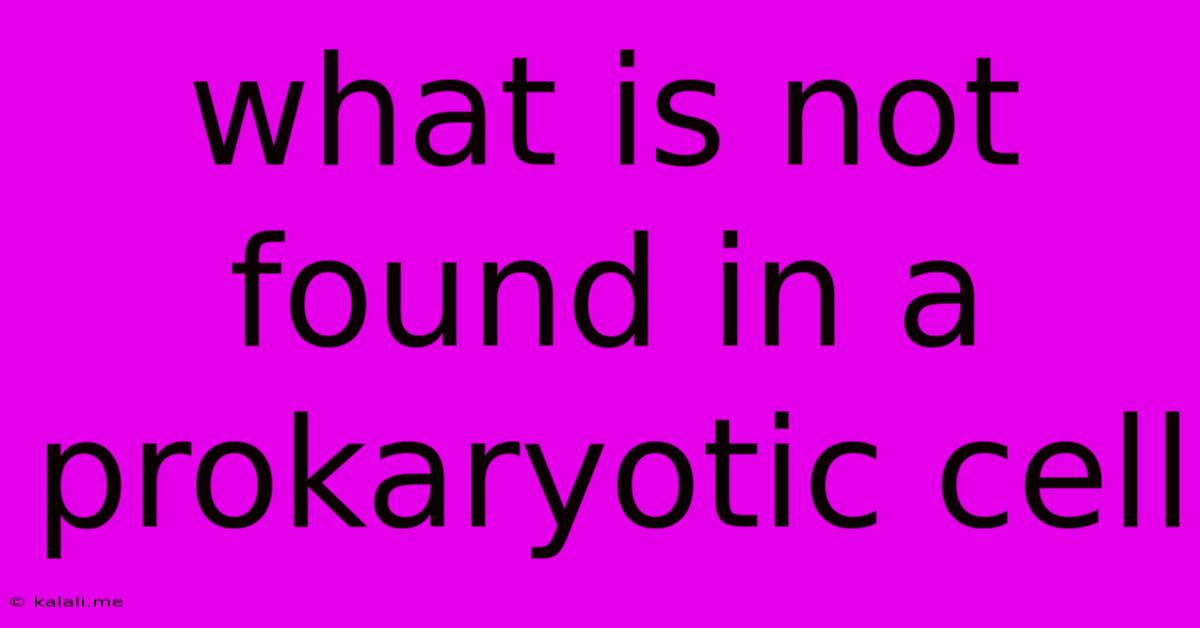What Is Not Found In A Prokaryotic Cell
Kalali
Jun 13, 2025 · 3 min read

Table of Contents
What's Missing in Prokaryotic Cells: A Deep Dive into Eukaryotic Distinctions
Prokaryotic cells, the simpler building blocks of life found in bacteria and archaea, are fascinating in their efficiency. But their simplicity means they lack several key features found in their more complex cousins, the eukaryotic cells. This article explores the crucial components absent in prokaryotic cells, highlighting the defining differences between these two fundamental cell types. Understanding these absences is key to grasping the evolutionary leap that led to the diversity of eukaryotic life.
What distinguishes prokaryotes from eukaryotes? It's all about the organelles! Eukaryotic cells boast a sophisticated internal organization, a feature entirely missing in prokaryotes. This internal organization is facilitated by membrane-bound organelles, specialized compartments performing specific cellular functions. Prokaryotes lack this intricate compartmentalization.
The Absence of Membrane-Bound Organelles: A Defining Feature
The most significant difference lies in the absence of membrane-bound organelles in prokaryotic cells. This means there's no:
-
Nucleus: The defining characteristic. In eukaryotes, the nucleus houses the genetic material (DNA) protected by a nuclear membrane. Prokaryotes, however, have their DNA concentrated in a nucleoid region, a less organized area within the cytoplasm. This lack of a nucleus significantly impacts gene regulation and expression.
-
Mitochondria: These powerhouses of the cell generate energy through cellular respiration. Prokaryotes lack mitochondria, relying on simpler mechanisms for energy production within their cytoplasm. This is linked to the endosymbiotic theory, suggesting mitochondria evolved from engulfed bacteria.
-
Endoplasmic Reticulum (ER): This extensive network of membranes plays a critical role in protein synthesis and lipid metabolism. Absent in prokaryotes, protein synthesis occurs directly in the cytoplasm.
-
Golgi Apparatus: This organelle processes and packages proteins for transport within or outside the cell. This sophisticated protein processing system is missing in prokaryotes.
-
Lysosomes: These organelles contain enzymes for breaking down waste materials and cellular debris. Prokaryotes utilize different mechanisms for waste management.
-
Chloroplasts: In photosynthetic eukaryotes, chloroplasts are responsible for photosynthesis. Photosynthetic prokaryotes, like cyanobacteria, perform photosynthesis using different structures within their cell membranes.
Other Notable Absences in Prokaryotic Cells
Beyond the lack of organelles, prokaryotic cells also typically lack:
-
Cytoskeleton: The complex network of protein filaments that provides structural support and facilitates movement in eukaryotic cells is absent or rudimentary in prokaryotes.
-
Complex Internal Membrane Systems: While some prokaryotes may have internal membrane systems, these are far less complex and organized than those found in eukaryotes. These systems are crucial for compartmentalization and specialized functions.
-
Large Ribosomes: While both prokaryotes and eukaryotes have ribosomes (responsible for protein synthesis), eukaryotic ribosomes are larger and more complex.
Implications of these Absences
The absence of these structures profoundly impacts the capabilities and complexity of prokaryotic cells. Their simpler structure allows for rapid reproduction and adaptation, making them incredibly successful in diverse environments. However, this simplicity also limits their potential for specialization and complexity compared to eukaryotic cells. The evolution of membrane-bound organelles was a pivotal step in the development of more complex life forms.
In conclusion, understanding what isn't present in prokaryotic cells is just as important as understanding what is. The absence of membrane-bound organelles and other complex structures highlights the fundamental differences between prokaryotic and eukaryotic cells, shaping their respective biological capabilities and evolutionary trajectories.
Latest Posts
Latest Posts
-
Unit Of Overall Heat Transfer Coefficient
Jun 14, 2025
-
How To Write A Letter Requesting A Promotion
Jun 14, 2025
-
Colorado School Of Mines Acceptance Rate Out Of State
Jun 14, 2025
-
Which Of The Following Is Part Of The Hydrosphere
Jun 14, 2025
-
The Internal Resistance Of An Ideal Voltage Source Is
Jun 14, 2025
Related Post
Thank you for visiting our website which covers about What Is Not Found In A Prokaryotic Cell . We hope the information provided has been useful to you. Feel free to contact us if you have any questions or need further assistance. See you next time and don't miss to bookmark.